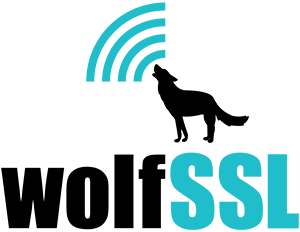RECENT BLOG NEWS
wolfSSL at Docker Hub
We at wolfSSL are pleased to announce that now you can use wolfSSL directly from Docker!
In a few words, Docker is a tool designed to make it easier to create, deploy, and run applications by using containers. Containers are like virtual machines, but way more lighter as the container shares some resources with the hosting machine.
We created a collection of wolfSSL containers targeting the following OSs: Debian, Ubuntu, Alpine Linux, CentOS
There are 3 different flavors of containers we have created based on each OS, they are: lib, test and examples
wolfssl/wolfssl ubuntu-examples 9198e6d82596 127MB wolfssl/wolfssl ubuntu-test ba5ca8ca4359 351MB wolfssl/wolfssl ubuntu-lib 125125eea7ab 126MB ubuntu latest 2d696327ab2e 122MB wolfssl/wolfssl debian-examples cd066ee3b5db 106MB wolfssl/wolfssl debian-test 5a3edb3a2a20 356MB wolfssl/wolfssl debian-lib 3086ef0f07b6 105MB debian latest 72ef1cf971d1 100MB wolfssl/wolfssl centos-examples 37687e96d5b9 222MB wolfssl/wolfssl centos-test 359d4195ca53 392MB wolfssl/wolfssl centos-lib a8c6cafd6205 221MB centos latest 196e0ce0c9fb 197MB wolfssl/wolfssl alpine-examples 490120f86d61 8.74MB wolfssl/wolfssl alpine-test 52b698631bec 228MB wolfssl/wolfssl alpine-lib 692a0c26cda6 7.97MB alpine latest 76da55c8019d 3.97MB
The -lib images contains only the wolfSSL binaries, while -examples also contains the test examples and -test also contains wolfSSL’s source code.
You can find further information on how to run wolfSSL examples on a docker container in our docker hub page: https://hub.docker.com/u/wolfssl/
And here is a quick example, server in the left tab and the client in the right tab:
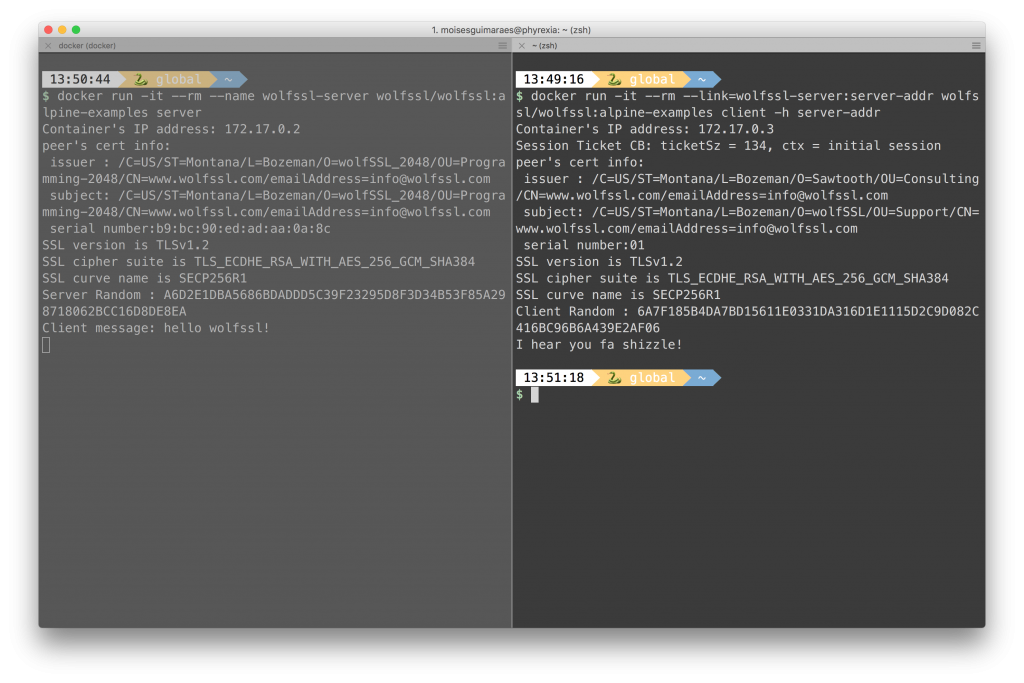
wolfSSL at XSWIG
wolfSSL recently presented at the XSWIG (Xilinx Security Working Group) in Longmont Colorado. Covering the topics of building wolfSSL for an Ultrazed EG starter kit and collecting benchmark values with hardware acceleration. If you would like more details of what we talked about, or are looking to add security to an FPGA embedded board contact us at facts@wolfssl.com!
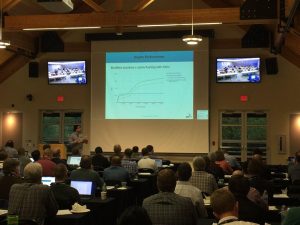
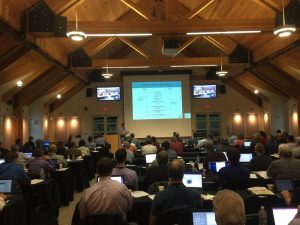
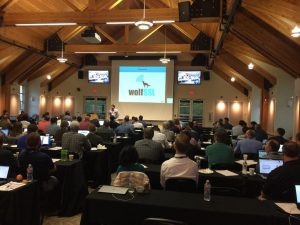
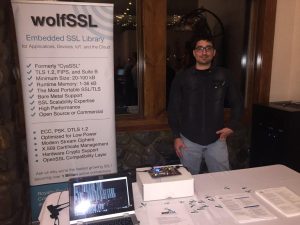


Breaking Ed25519 paper using wolfSSL
A recent paper used wolfSSL as a test bed for proving out their attack on Ed25519 signatures. You can read the paper here: https://eprint.iacr.org/2017/985.pdf . This was not an attack on wolfSSL itself or its implementation, but rather a differential power attack that involves SHA-512 and Ed25519. The recommended countermeasure is to change Ed25519 and remove its deterministic signature properties. If you are interested in this countermeasure please let us know as we can make this available as a build option.
KRACK Attacks: Wi-Fi Security Has Been Breached
According to a recent article, researchers have announced that Wi-Fi security has a protocol level exploit that can render all Wi-Fi traffic vulnerable to sniffing or manipulation. The good news is that if you are already using an independent form of end-to-end encryption such as SSL/TLS then the stolen packets are of little use as they are encrypted independent of the WEP/WPA1/WPA2 protocols.
These vulnerabilities are scheduled to be presented on November 1st at the 24th annual “ACM Conference on Computer and Communications Security” to be held in Dallas, TX.
Paper Title:
“Key Reinstallation Attacks: Forcing Nonce Reuse in WPA2”
Authors:
Mathy Vanhoef (KU Leuven, imec-DistriNet)
Frank Piessens (KU Leuven, imec-DistriNet)
Securing your Wi-Fi traffic with SSL/TLS, offered by @wolfSSL, can keep your data secure in a wireless world by providing independent end-to-end security for your Wi-Fi traffic rendering any stolen Wi-Fi traffic useless to attackers. Users MUST BE AWARE and look for the green lock to ensure the SSL/TLS was not stripped while using Wi-Fi (See video below for explanation!)
PLEASE WATCH THIS VIDEO so you know how to detect if SSL/TLS has been STRIPPED and your traffic is vulnerable to sniffing and/or modification!
An addendum to the report notes that all WPA Supplicant users using v2.6 are vulnerable to this attack (All android 6.0+ users).
References:
https://www.theverge.com/2017/10/16/16481136/wpa2-wi-fi-krack-vulnerability
https://www.wired.com/story/krack-wi-fi-wpa2-vulnerability/
Internship Info Session and MSU Fall Career Fair
In preparation for the 2018 Fall Career Fair at MSU Bozeman, wolfSSL will be holding an info session this upcoming Thursday at Montana State University in Bozeman, MT for students interested in learning more about wolfSSL and our upcoming 2018 Summer internship program. The session will introduce wolfSSL as a company – including background information, product lineup, work environment, and more.
We encourage any students who are interested in Internet security, SSL/TLS, cryptography, embedded security, or software development to attend! Pizza will be served.
wolfSSL Info Session
Thursday, September 28, 2017
Montana State University, Bozeman
5-6pm, Roberts Hall 321
We look forward to seeing you there! Feel free to contact chris@wolfssl.com with any questions or for more information. To learn more about the wolfSSL lightweight SSL/TLS library, visit our product page, or download the Open Source version today!
wolfSSL Intel SGX Testing
wolfSSL has support for Intel SGX and we do continuous integration testing on that support. This means that every night a process starts up and runs unit tests on crypto operations in a secure Enclave. Here’s a peek at some of the on going tests in action
…
LINK => App
GEN => trusted/Wolfssl_Enclave_t.c
CC <= trusted/Wolfssl_Enclave_t.c
cc -Wno-implicit-function-declaration -std=c11 -m64 -O2 -nostdinc -fvisibility=hidden -fpie -fstack-protector -IInclude -Itrusted -I../..// -I../..//wolfcrypt/ -I/opt/intel/sgxsdk/include -I/opt/intel/sgxsdk/include/tlibc -I/opt/intel/sgxsdk/include/stlport-fno-builtin -fno-builtin-printf -I. -DWOLFSSL_SGX -DHAVE_WOLFSSL_TEST -c trusted/Wolfssl_Enclave.c -o trusted/Wolfssl_Enclave.o
CC <= trusted/Wolfssl_Enclave.c -m64 -O2 -Wl,--no-undefined -nostdlib -nodefaultlibs -nostartfiles -L/opt/intel/sgxsdk/lib64 -L../../IDE/LINUX-SGX/ -lwolfssl.sgx.static.lib -Wl,--whole-archive -lsgx_trts -Wl,--no-whole-archive -Wl,--start-group -lsgx_tstdc -lsgx_tstdcxx -lsgx_tcrypto -lsgx_tservice -Wl,--end-group -Wl,-Bstatic -Wl,-Bsymbolic -Wl,--no-undefined -Wl,-pie,-eenclave_entry -Wl,--export-dynamic -Wl,--defsym,__ImageBase=0 -Wl,--version-script=trusted/Wolfssl_Enclave.lds@ LINK => Wolfssl_Enclave.so
…
SIGN => Wolfssl_Enclave.signed.so
+ ./App -t
Crypt Test:
error test passed!
base64 test passed!
base64 test passed!
MD5 test passed!
MD4 test passed!
SHA test passed!
SHA-256 test passed!
Hash test passed!
HMAC-MD5 test passed!
HMAC-SHA test passed!
HMAC-SHA256 test passed!
GMAC test passed!
ARC4 test passed!
HC-128 test passed!
Rabbit test passed!
DES test passed!
DES3 test passed!
AES test passed!
AES192 test passed!
AES256 test passed!
AES-GCM test passed!
RANDOM test passed!
RSA test passed!
DH test passed!
DSA test passed!
PWDBASED test passed!
ECC test passed!
ECC buffer test passed!
mutex test passed!
memcb test passed!
Crypt Test: Return code 0
…
Interested in using FIPS with SGX or questions about wolfSSL testing? Contact us at facts@wolfssl.com.
wolfSSL with Improved ThreadX/NetX Support
wolfSSL has supported the ThreadX/NetX RTOS with the TLS protocol. Recently we added the ability to use DTLS with NetX. Out of the box, wolfSSL has the I/O callback functions for handling UDP packets for DTLS. As an extension to DTLS, wolfSSL also supports Multicast DTLS. If you would like to know more please contact our sales team via email, sales@wolfssl.com
How to use the 0-RTT rope to climb, without hanging yourself!
One of the major new features of TLS v1.3 is the 0-RTT handshake protocol. This variation of the handshake, using Pre-Shared Keys (PSKs), allows the client to send encrypted data to the server in the first flight. This is particularly useful for TLS on embedded devices. Take the example of IoT. There may be thousands or even millions of devices reporting back regularly to the central servers with small updates.
Using 0-RTT, the IoT device can send a ClientHello plus all the update data, known as “early data”, in one flight. Then, the server responds with the ServerHello, EncryptedExtensions, and Finished messages plus acknowledgement of the early data all in one flight. Finally the device responds with EndOfEarlyData and Finished messages in a final flight to close the loop on the security.
We can see that the data is offloaded, without having to wait for the server. The device stores a little state and goes back to its job ready for the interrupt on response. If the response times out then the server can resend with an updated ClientHello. On response, the device processes the handshake messages and responds closing the connection and the update can be discarded.
This is all very efficient in terms of processing and overall round-trip time. But, there are potential security issues including: replay attacks and no forward security.
An attacker can replay messages from a device. The server decrypts the early data using a key directly derived from the PSK and no other authentication is performed. Without the second flight from the client, the server would not recognize the copy is invalid. The recommended defense is single-use tickets. Each ticket contains a fresh PSK. This has the downside of requiring a shared database of tickets across servers. Alternatively, unique values from the ClientHello used with each PSK can be stored instead.
The attacker may also intercept the client’s first flight and spam the server with copies. If the early data contains “state modifying” data as in the example above, processing a copy would be disastrous. If the PSK is single-use, the client will get out of sync with the server and a full handshake will be required. The server may well interpret the attack as the client attempting to retry and therefore this must be handled at the application level.
When the PSK is reused for a number of messages, forward secrecy is lost. This means that if a device is compromised all messages encrypted using keys derived from the current PSK are exposed. The recommended defense is to use a short timeout with tickets to limit the period of vulnerability.
Using 0-RTT does require more careful architecture on the server side, the benefits at the client side are worth it.
Overview of Testing in wolfSSL
The security of wolfSSL products is always on our mind and holds high importance. Conducting regular, diligent, and well-planned testing helps maintain wolfSSL’s robustness and security. We strive to write and maintain clean, readable, and understandable code.
Like the halting problem, we know it is impossible to test every single possible path through the software, but we practice an approach that is focused on lowering risk of failure. In addition to extensive automated testing, we make sure that we specifically test well-known use cases. This post outlines some of our internal testing process.
-
API Unit Testing: We have unit tests in place that test API functions for correct behavior. This helps maintain library consistency across releases and as the code evolves. It helps us to deliver a high quality well tested API to our end users with each software release. API unit tests are run with each “make check” of wolfSSL.
-
Cipher Suite Testing: wolfSSL supports an extensive list of cipher suites, which are all tested with every “make check” using the wolfSSL example client and example server. Each cipher suite is tested not only in the default configuration, but also in non-blocking mode and with client authentication both turned on/off.
-
Algorithm Testing: The security of our SSL/TLS implementation depends on the correctness and robustness of our underlying cryptography library, wolfCrypt. We test all algorithms using NIST test vectors in addition to running our CAVP test harness used for our FIPS 140-2 validations. We also test on both big and little endian platforms for portability.
-
Benchmark Testing: We engage in another ever expanding universe of benchmark testing, where we look at sizing, transmission rates, connection speeds, and cryptography performance. A version of our benchmark suite is included in every download for users to enjoy!
-
Static Analysis: We do static analysis on our entire codebase using not only one, but multiple different static analysis tools. We currently use Coverity Scan, clang scan-build, and Facebook infer. These tools help us to automatically find bugs including ones on low-traffic code paths.
-
Detecting Memory Errors: We mitigate memory errors by using valgrind on a regular and automated basis. This helps find memory errors including invalid access, use of undefined values, incorrect freeing of dynamic memory, and memory leaks.
-
Interop Testing: We test for interoperability with other Open Source TLS implementations, including OpenSSL, BoringSSL, and GnuTLS. This helps us to catch any protocol implementation errors in either wolfSSL or the implementation being tested against. We also test outside of a closed environment by connecting to servers in the real world running unknown SSL/TLS implementations.
-
Real World Builds: We build with a series of ‘real’ applications, like cURL, wget, pppd, OpenSSH, stunnel, lighttpd, etc. For some of our customers with top level support, we build new releases with their application.
-
Compiler Testing: We have users who compile wolfSSL with a variety of different compilers. As such, we test compiling wolfSSL with many different compilers and toolchains including gcc/g++, clang, icc, Visual Studio, CodeWarrior, KDS, LPCXpresso, MPLAB XC, TI CCS, Keil, IAR, Cygwin, MinGW, CrossWorks, Arduino, Wind River Workbench, and more.
-
Peer Review: More eyes on a codebase reduces bugs that end up in a final product. Internally, we operate using a “Fork and Pull Request” model. This means that every commit that makes it into our master branch has been reviewed and tested by at least two separate engineers.
-
Third Party Testing: Our code is regularly reviewed by university researchers, customer and user security teams, FIPS and certification labs, and our Open Source user base. This helps put more eyes on our code and product architecture.
-
Fuzz Testing: We test using several different software fuzzers, including an in-memory fuzzer, a network fuzzer, OSS-fuzz, libfuzzer, tlsfuzzer, and AFL. Fuzz testing bombards the program with invalid, unexpected, and random data that then allows for observing if there is potential memory leaks or logic errors. This allows us to catch bugs that could turn into potential vulnerabilities if released in a final release.
-
Continuous Integration (CI): Leveraging Jenkins, we run tests on each commit submitted to the wolfSSL code repository. Tests run on each commit include testing of our FIPS build, numerous build options (customer/user/common), running valgrind, and doing static analysis with scan-build.
-
Nightly Test Cycle: Each night we run extended tests that last longer than the typical ones during the work day. These are more in-depth than our CI testing and puts results in our engineers’ inboxes each morning. Some tests included in our nightly cycle include extended build option testing on multiple platforms with multiple compilers, and extended fuzz testing.
If you have specific questions about how we test, please contact us at facts@wolfssl.com. If you would like us to include your SSL/TLS or crypto implementation in our interop testing, please let us know! Likewise, if you would like to include wolfSSL in your own test framework, we would be happy to discuss.
wolfSSL STM32F7 Support
We would like to announce that the wolfSSL embedded SSL library now has support for hardware-based cryptography and random number generation offered by the STM32F7. Supported cryptographic algorithms include AES (CBC, CTR), DES (ECB, CBC), 3DES, MD5, and SHA1. For details regarding the STM32F7 crypto and hash processors, please see the STM32F7 Hardware Abstraction Layer (HAL) and Low-layer drivers document (linked below).
If you are using the STM32F7 with wolfSSL, you can see substantial speed improvements when using the hardware crypto versus using wolfSSL’s software crypto implementation. The following benchmarks were gathered from the wolfCrypt benchmark application (wolfcrypt/benchmark/benchmark.c) running on the STM32F777NI board (STM32F7) using the STM32F7 HAL on bare metal (No OS).
wolfSSL Software Crypto, Normal Big Integer Math Library
RNG 3 MB took 1.000 seconds, 3.149 MB/s
AES-Enc 6 MB took 1.000 seconds, 6.494 MB/s
AES-Dec 7 MB took 1.000 seconds, 6.519 MB/s
AES-GCM-Enc 3 MB took 1.004 seconds, 2.553 MB/s
AES-GCM-Dec 3 MB took 1.004 seconds, 2.553 MB/s
AES-CTR 7 MB took 1.000 seconds, 6.543 MB/s
CHACHA 16 MB took 1.000 seconds, 15.723 MB/s
CHA-POLY 10 MB took 1.000 seconds, 10.474 MB/s
3DES 1 MB took 1.008 seconds, 1.405 MB/s
MD5 24 MB took 1.000 seconds, 24.243 MB/s
POLY1305 42 MB took 1.000 seconds, 41.821 MB/s
SHA 14 MB took 1.000 seconds, 14.380 MB/s
SHA-224 8 MB took 1.000 seconds, 8.423 MB/s
SHA-256 8 MB took 1.000 seconds, 8.423 MB/s
SHA-384 2 MB took 1.000 seconds, 2.319 MB/s
SHA-512 2 MB took 1.000 seconds, 2.319 MB/s
STM32F7 Hardware Crypto, Normal Big Integer Math Library
RNG 6 MB took 1.000 seconds, 6.030 MB/s
AES-Enc 30 MB took 1.000 seconds, 30.396 MB/s
AES-Dec 30 MB took 1.000 seconds, 30.371 MB/s
AES-GCM-Enc 42 MB took 1.000 seconds, 42.261 MB/s
AES-GCM-Dec 33 MB took 1.000 seconds, 32.861 MB/s
AES-CTR 48 MB took 1.000 seconds, 47.827 MB/s
CHACHA 16 MB took 1.000 seconds, 15.747 MB/s
CHA-POLY 11 MB took 1.000 seconds, 10.522 MB/s
3DES 13 MB took 1.000 seconds, 12.988 MB/s
MD5 41 MB took 1.000 seconds, 40.894 MB/s
POLY1305 42 MB took 1.000 seconds, 41.846 MB/s
SHA 38 MB took 1.004 seconds, 38.202 MB/s
SHA-224 41 MB took 1.000 seconds, 41.309 MB/s
SHA-256 39 MB took 1.000 seconds, 39.111 MB/s
SHA-384 2 MB took 1.004 seconds, 2.310 MB/s
SHA-512 2 MB took 1.004 seconds, 2.310 MB/s
As the above benchmarks (and chart) show, the hardware-based algorithms on the STM32F7 demonstrate significantly faster speeds than that of their software counterparts.
To enable STM32F7 hardware crypto and RNG support, define WOLFSSL_STM32F7 when building wolfSSL. For a more complete list of defines which may be required, please see the WOLFSSL_STM32F7 define in <wolfssl_root>/wolfssl/wolfcrypt/settings.h. You can find the most recent version of wolfSSL on GitHub, here: https://github.com/wolfssl/wolfssl.
If you would like to use wolfSSL with STM32F7 hardware-based cryptography or RNG, or have any questions, please contact us at facts@wolfssl.com for more information.
STM32: http://www.st.com/internet/mcu/class/1734.jsp
STM32F7 HAL and Low-layer drivers documentation: http://www.st.com/content/ccc/resource/technical/document/user_manual/45/27/9c/32/76/57/48/b9/DM00189702.pdf/files/DM00189702.pdf/jcr:content/translations/en.DM00189702.pdf
Weekly updates
Archives
- April 2024 (25)
- March 2024 (21)
- February 2024 (18)
- January 2024 (21)
- December 2023 (20)
- November 2023 (20)
- October 2023 (23)
- September 2023 (17)
- August 2023 (25)
- July 2023 (39)
- June 2023 (13)
- May 2023 (11)
- April 2023 (6)
- March 2023 (23)
- February 2023 (7)
- January 2023 (7)
- December 2022 (15)
- November 2022 (11)
- October 2022 (9)
- September 2022 (7)
- August 2022 (12)
- July 2022 (11)
- June 2022 (15)
- May 2022 (11)
- April 2022 (14)
- March 2022 (12)
- February 2022 (22)
- January 2022 (13)
- December 2021 (13)
- November 2021 (29)
- October 2021 (15)
- September 2021 (15)
- August 2021 (13)
- July 2021 (21)
- June 2021 (19)
- May 2021 (12)
- April 2021 (13)
- March 2021 (27)
- February 2021 (29)
- January 2021 (22)
- December 2020 (21)
- November 2020 (14)
- October 2020 (7)
- September 2020 (22)
- August 2020 (11)
- July 2020 (8)
- June 2020 (14)
- May 2020 (15)
- April 2020 (14)
- March 2020 (4)
- February 2020 (24)
- January 2020 (18)
- December 2019 (7)
- November 2019 (16)
- October 2019 (14)
- September 2019 (24)
- August 2019 (21)
- July 2019 (8)
- June 2019 (13)
- May 2019 (35)
- April 2019 (31)
- March 2019 (20)
- February 2019 (10)
- January 2019 (16)
- December 2018 (24)
- November 2018 (10)
- October 2018 (18)
- September 2018 (18)
- August 2018 (8)
- July 2018 (15)
- June 2018 (29)
- May 2018 (15)
- April 2018 (11)
- March 2018 (19)
- February 2018 (6)
- January 2018 (11)
- December 2017 (5)
- November 2017 (12)
- October 2017 (7)
- September 2017 (8)
- August 2017 (6)
- July 2017 (11)
- June 2017 (8)
- May 2017 (10)
- April 2017 (5)
- March 2017 (7)
- February 2017 (1)
- January 2017 (8)
- December 2016 (3)
- November 2016 (2)
- October 2016 (18)
- September 2016 (8)
- August 2016 (5)
- July 2016 (4)
- June 2016 (10)
- May 2016 (4)
- April 2016 (5)
- March 2016 (4)
- February 2016 (12)
- January 2016 (6)
- December 2015 (4)
- November 2015 (6)
- October 2015 (6)
- September 2015 (5)
- August 2015 (8)
- July 2015 (7)
- June 2015 (9)
- May 2015 (1)
- April 2015 (4)
- March 2015 (13)
- January 2015 (6)
- December 2014 (7)
- November 2014 (3)
- October 2014 (2)
- September 2014 (11)
- August 2014 (6)
- July 2014 (9)
- June 2014 (11)
- May 2014 (11)
- April 2014 (9)
- March 2014 (3)
- February 2014 (3)
- January 2014 (5)
- December 2013 (9)
- November 2013 (4)
- October 2013 (7)
- September 2013 (3)
- August 2013 (9)
- July 2013 (7)
- June 2013 (4)
- May 2013 (8)
- April 2013 (4)
- March 2013 (2)
- February 2013 (3)
- January 2013 (9)
- December 2012 (13)
- November 2012 (5)
- October 2012 (7)
- September 2012 (4)
- August 2012 (6)
- July 2012 (4)
- June 2012 (3)
- May 2012 (5)
- April 2012 (7)
- March 2012 (2)
- February 2012 (5)
- January 2012 (7)
- December 2011 (5)
- November 2011 (7)
- October 2011 (6)
- September 2011 (6)
- August 2011 (5)
- July 2011 (2)
- June 2011 (8)
- May 2011 (12)
- April 2011 (4)
- March 2011 (12)
- February 2011 (8)
- January 2011 (13)
- December 2010 (17)
- November 2010 (12)
- October 2010 (14)
- September 2010 (11)
- August 2010 (20)
- July 2010 (14)
- June 2010 (7)
- May 2010 (1)
- January 2010 (2)
- November 2009 (2)
- October 2009 (1)
- September 2009 (1)
- May 2009 (1)
- February 2009 (1)
- January 2009 (1)
- December 2008 (1)

